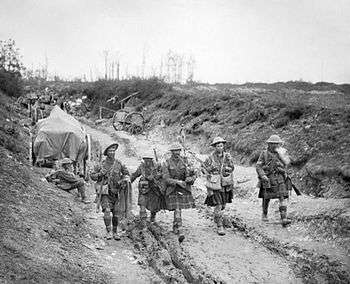9th (Scottish) Division
| 9th (Scottish) Division | |
|---|---|
_Division_Insignia.png) | |
| Active | 21 August 1914 – 16 March 1919 |
| Country |
|
| Branch |
|
| Type | Infantry |
| Size | Division |
| Engagements |
|
The 9th (Scottish) Division, was an infantry division of the British Army during World War I, one of the Kitchener's Army divisions raised from volunteers by Lord Kitchener to serve on the Western Front during the First World War.
After the 1st South African Infantry Brigade Group joined in early 1916, the division was known colloquially as the Jock and Springboks.
Unit history
In the Battle of Loos, notable for being the first battle in which British forces used poison gas, the 9th (Scottish) Division assaulted the Hohenzollern Redoubt, the 5th Camerons suffered horrific casualties, and Corporal James Dalgleish Pollock gained a Victoria Cross for his actions.

The 9th (Scottish) Division took part in major fighting during the Somme offensive. Notably it relieved the 30th Division at Montauban and later attacked German positions at Bernafay Wood, where it succeeded in capturing vital objectives and forcing a German withdrawal. In the Somme offensive, the 9th (Scottish)) Division liberated the village of Longueval, the village now has a statue of a Scottish piper at its crossroads that commemorates this fact and also other pipers who served in World War I.
Formation
The division comprised the following brigades:
- 8th (Service) Battalion, Black Watch (Royal Highlanders)
- 7th (Service) Battalion, Seaforth Highlanders (Ross-shire Buffs, Duke of Albany's)
- 8th (Service) Battalion, Gordon Highlanders[1]
- 5th (Service) Battalion, Queen's Own Cameron Highlanders
- 10th (Service) Battalion, Argyll and Sutherland Highlanders[2]
- 11th (Service) Battalion, Royal Scots (Lothian Regiment)
- 12th (Service) Battalion, Royal Scots (Lothian Regiment)
- 6th (Service) Battalion, Royal Scots Fusiliers[3]
- 10th (Service) Battalion, Argyll and Sutherland Highlanders[2]
- 6th (Service) Battalion, King's Own Scottish Borderers[4]
- 9th (Service) Battalion, Cameronians (Scottish Rifles)[5]
The 28th Brigade was broken up in May 1916 and replaced with 28th (South African) Brigade.
- 6th (Service) Battalion, King's Own Scottish Borderers[4]
- 9th (Service) Battalion, Cameronians (Scottish Rifles)[5]
- 10th (Service) Battalion, Highland Light Infantry[6]
- 11th (Service) Battalion, Highland Light Infantry[6]
- 1st Battalion, Royal Newfoundland Regiment September 1918 - March 1919
Replaced 28th Brigade in May 1916.
- 1st Battalion, South African Infantry[7]
- 2nd Battalion, South African Infantry[7]
- 3rd Battalion, South African Infantry
- 4th Battalion, South African Infantry[7]
- Pioneers
- 9th (Service) Battalion, Seaforth Highlanders (Rosshire Buffs, The Duke of St. Albany's)
General Officers Commanding
Commanders have included:[8]
- 27 August 1914 – 11 October 1914 Major-General Colin Mackenzie
- 26 October 1914 – 31 December 1914 Lieutenant-General Sir Charles Fergusson
- 21 January 1915 – 8 September 1915 Major-General Herman Landon
- 8–26 September 1915 Major-General George Thesiger
- 28 September 1915 – 2 December 1916 Major-General William Furse
- 2 December 1916 – 4 March 1918 Major-General Henry Lukin
- 13–16 March 1918 Major-General Cyril Blacklock
- 28 March 1918–1919 Major-General Hugh Tudor
See also
- List of British divisions in World War I
- British 9th (Highland) Infantry Division (for World War II)
References
- ↑ Transferred to 15th (Scottish) Division and amalgamated with the 10th (Service) Battalion, Gordon Highlanders in May 1916
- 1 2 Transferred to 26th Brigade and replaced 8th (Service) Battalion, Gordon Highlanders May, 1916. Transferred to 32nd Division in February 1918.
- ↑ Transferred to the 15th (Scottish) Division and amalgamated with the 7th (Service) Battalion, Royal Scots Fusiliers in May 1916.
- 1 2 Transferred to the 27th Brigade and replaced the 6th Battalion, Royal Scots Fusiliers in May 1916.
- 1 2 Transferred to the 27th Brigade and replaced the 10th (Service) Battalion, Argyll and Sutherland Highlanders in May 1916. Transferred to the 14th (Light) Division in February 1918, rejoined the 9th (Scottish) Division, 28th Brigade April 1918.
- 1 2 Amalgamated May 1916 and transferred to 15th Division.
- 1 2 3 Amalgamated into South African (Composite Regiment) April 1918 due to heavy casualties, Battalions reformed September 1918.
- ↑ Army Commands Archived 5 July 2015 at the Wayback Machine.
External links
Further reading
- Ewing, J. (2001) [1921]. The History of the Ninth (Scottish) Division 1914–1919 (Naval & Military Press ed.). London: John Murray. ISBN 1-84342-190-9. Retrieved 31 December 2014.